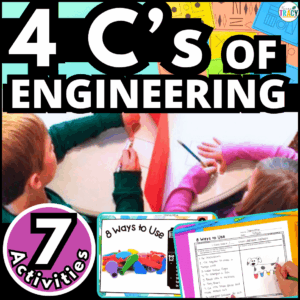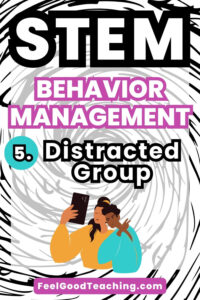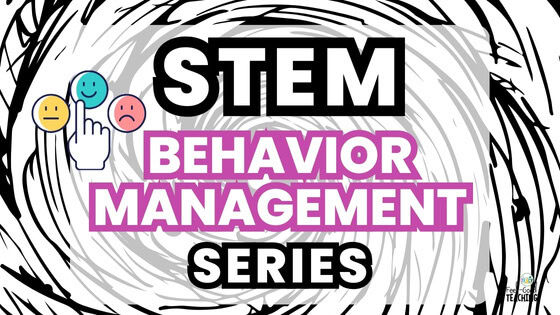Trying to refocus distracted students can feel like an uphill battle some days! So let’s take a look at a few simple classroom management strategies to keep group work productive during STEM challenges for our off-task teams.
This post is part of the STEM Classroom Management series.
Today, let’s talk about a common group dynamic that drives us all a little crazy:
Meet The Distracted Group
You give the challenge instructions, release the students to begin… and this group immediately starts:
- Chatting about last weekend
- Playing with materials in weird ways (more on this in the next post)
- Trying to get friends off-task
- Or simply doing anything but STEM
This group doesn’t need conflict resolution or confidence boosting; they need a reset.
How can we help distracted teams get focused and stay productive without constant reminders or power struggles? Let’s start with the why…
Why STEM Groups Get Distracted
Even well-meaning students can drift off task during a STEM challenge. Some common causes:
Common root causes:
- Lack of clarity: Students don’t fully understand the task or goal, so they stall or play.
- No ownership: If only one teammate is doing the thinking, others may check out.
- Tempting materials: Some kids just can’t resist messing around.
- Poor group chemistry: A mismatch in energy levels, friendships, or learning styles can lead to off-task chaos.
- Not enough structure: STEM challenges are open-ended, and some students need structure to stay focused
Strategies to Refocus the Distracted Group
Here are some go-to ways to gently redirect off-task teams while still supporting collaboration, creativity, and fun.
🌍 Before the Challenge: Set the Stage
1️⃣ Roles … again. Having clear roles & NOT having clear roles can both cause problems, so be prepared to switch your approach either way. Some students get off task if they don’t like the role they are assigned. Others need a clearly defined job to stay grounded in the activity at hand.
I generally don’t assign roles; I prefer an organic approach to teaching collaboration, but I am always willing to revisit a strategy when my current one stops working. That’s teaching, right? Every year and every class is different!
You might not even need to assign roles to everyone in the group. If there are just a few students struggling to stay on task, you might quietly ask them to be the Design Moderator which puts them in charge of keeping everyone else on task. It’s like a Jedi mind trick that almost tricks them into being on track. Here’s what the moderator does:
- Makes sure all group members are participating
- Redirects interruptions
- Reviews the criteria & constraints and lets team know if they’re missing something
- Reviews the rubric & lets team know if they aren’t at a “4” (see 6️⃣ below)
Other common roles are materials manager, recorder, time keeper, presenter, sketch artist, etc.
2️⃣ Use visual instructions. Include a timeline / outline on the board of the day’s tasks and check each one off as you go. This could be the steps pop the engineering design process, or a simplified version (plan, build, test, share, record/reflect, clean up).
3️⃣ Preview expectations clearly. Try: “You’ll have 20 minutes to design, 10 minutes to test, and 5 minutes to reflect.”
4️⃣ Post a timer. Let students know they have 5 minutes to plan. If you can’ post a timer, call out when half of their time has elapsed, there is one minute left, etc.
5️⃣ Review what teamwork should look like. Use the 4 Cs Posters to revisit collaboration & communication norms.
6️⃣ Choose a rubric with clear participation criteria. Choose the right rubric for your goals and review with students before the challenge begins. Let them keep a copy at their table and set a goal for themselves before the challenge begins.
7️⃣ Explore materials. If you’re introducing a new or tempting material, like LEGO, it may help to give 3-5 minutes to play & explore before the challenge begins.
⏱️ During the Challenge: Redirect with Purpose
📌 Use strategic proximity. Simply standing near a distracted team often brings focus back fast.
📌 Redirect with questions. Instead of, “Get to work!” try:
- “What step are you on right now?”
- “What’s your plan for solving the challenge?”
- “Can you explain how this criterion is (or will be) met in your design?”
- “How are you tracking to your rubric goals so far?”
📌 Pause the class for a mid-point check-in. Ask all groups:
- Have you tested yet?
- Do you need to adjust your design?
- What’s one thing you’re doing well?
- What’s one thing you want to improve?
📌 Highlight great teamwork aloud.
“I noticed a group just had a problem. Everyone shared ideas to move forward & they combined a few to move forward. That’s great teamwork!”
📌 Limit materials until the team earns them. If needed, you can hold back build materials until a team submits a sketch or plan. (Mishandling materials is a big enough issue to warrant its own post in this series. I’m working on that one next, stay tuned!)
🔄 After the Challenge: Reflect & Reset
⭐️ Use a group behavior rubric. Let teams reflect on how they worked together.
⭐️ Think of self redirection as a learning objective. When I find myself frustrated by a behavior, it helps me to stop thinking of it as an obstacle to the activity and consider behavior management / SEL as an important part of the lesson worthy of any time it “takes away” from the base activity. (You may not need that mental reset, but I sure do sometimes!)
⭐️ Name the wins. If a previously distracted group gets it together, say so:
“You were much more focused today. Your design really shows it!”
⭐️ Ask for their ideas.
“What would help your team stay focused during the next challenge?”
“What helped you stay on task? What pulled you off? “Students often have great insights if we take the time to ask. It can also be helpful to have students create a procedure to help teammates stay on track. Post it where they can refer to it.
✅ Keep Fun Without the Chaos
A distracted group isn’t a lost cause. Most kids want to engage. They just need clarity, structure, and purpose to stay on track.
By building in those supports early, you can save yourself time (and stress!) during every challenge.
💡 Want a Free STEM Behaviors SEL Handbook?
I’ve put together a printable copy of these strategies, as well as navigating the other tricky STEM behaviors in this series. It’s perfect for keeping in your lesson planner or sharing at your next PLC or team meeting.
Helpful Resources for You:
For more practice on the 4 Cs of Engineering:

STEM Rubrics and Post-Build Routines:
✨ Next in the Series…
In our next post of this series, we’ll talk about one of the most challenging situations of all: The Destructive Disruptor: students who destroy or misuse materials or intentionally sabotage group work.
Explore all posts in the STEM Classroom Management Series here.
Pin it. Share it. Save it. Let’s build better teams, one STEM challenge at a time. 🚀
Every challenge is a chance to teach collaboration. Let’s help students disagree productively.






